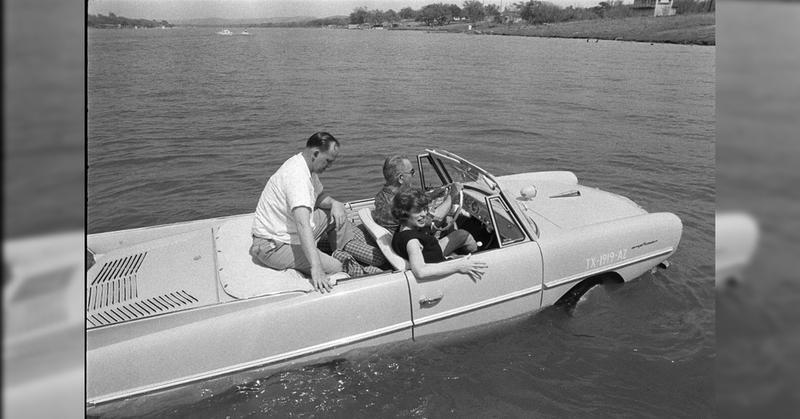Lyndon Johnson Had An Amphibious Car, Didn't You?
By | February 14, 2019

Do we need an amphibious car? Lyndon Johnson thought so. President Lyndon B. Johnson was one of a relatively few people who owned an Amphicar, a seaworthy automobile that was produced in West Germany from 1961-65, and sold through 1968.
The Amphicar is a footnote in the history of the auto industry -- mainly for the reason that its utility was debatable. Hans Trippel and his company, Quandt Group, succeeded in making a car that could be driven off of a road and into or across a body of water. But how often was this feature needed?
Lyndon Johnson, one of the great practical jokers the Oval Office has ever seen, felt it was actually needed on several occasions. When the 36th President of the United States invited guests to his Texas ranch, he loved to pile them into this unusual-looking car, without telling them of its amphibious capabilities, and take them on a tour of the ranch. As they would start down a steep incline toward a lake, Johnson would start yelling about brake problems and send the vehicle straight into the water as his terrified guests cried, screamed, and prayed.
What Was The Amphibious Car?

As the name suggests, amphibious cars were like traditional motor cars, but with a twist. They could convert to a motorboat. The Amphicar Model 770, designed by the German engineer Hans Trippel, was first unveiled at the New York Auto Show in 1961 and promised to revolutionize travel. But that never happened.
Amphicars were Manufactured Between 1961 and 1965

Between 1961 and 1965, almost 4,000 Amphicars were built by the Quandt Company of West Germany. Although the Amphicar was conceived and built in Germany, the target market was Americans. In the 1960s, Americans had a great love affair with their sports cars and the Amphicar was marketed as “the sports car that swims.” It was intended for sand and surf lovers who wanted to cruise the open roads and the open waters, all in one convenient and stylish vehicle. In fact, the 770 in the Amphicar 770’s name represented 7 knots and 70 miles per hour -- the top speed of the Amphicar in water and on land.
The Amphicar Didn’t Transform Like a Cartoon Car

Cartoons of the day sometimes showed Transformer-like cars morphing into boats, but the Amphicar didn’t work that way. The structure of the car didn’t change as it made the transition from land to sea. That’s because the amphibious features were built right into the car. The undercarriage was encased in a smooth, watertight hull. The doors had a double seal-locking mechanism to keep the water out. A simple switch on the dashboard allowed the driver to change the transmission from wheel-driven to twin-propeller-driven and the steering wheel to change from moving the wheels to moving the rudders. The Amphicar even came standard with Coast Guard approved boating lights, oars, and life jackets.
A Marketing Stunt Sought to Increase Interest in the Amphicar

Sales of the Amphicar were rather slow, so in September of 1965, the marketing team at Quant came up with what they thought would be the perfect marketing stunt to attract attention to the Amphicar. They planned to send two Amphicars from London to the Frankfurt Auto Show in Germany … and the cars would drive there. That meant the Amphicars would have to drive overland from London to Dover, then motor across the English Channel to Calais, then drive again from Calais to Frankfurt. Of course, the stunt would be filmed and documented to show off the versatility and performance of the Amphicar. But things didn’t go as planned.
The Amphicars Encountered Trouble at Sea

The trek to Dover was uneventful, but the English Channel proved to be a challenge for the Amphicars. The vehicles encountered high winds and choppy seas and water splashed into the open, convertible-style seating area. The Amphicars were equipped with bilge pumps to remove water and the drivers had those working at full capacity. But the pump in one of the Amphicars became clogged and stopped working. Soon after, the engine flooded and quit. The Amphicar was powerless to move, so the second Amphicar had to tow it to shore. Once in Calais, the working Amphicar needed to be refueled and dried out, but was able to complete the journey to Frankfurt, and rolled into the Frankfurt Auto Show to much applause.
The Amphicar Failed to Make a Splash

While it is true that the 1965 marketing stunt did generate some interest in the Amphicar, the sales were still sluggish. People viewed the Amphicar as a novelty item, not a car that they would drive on a daily basis. The Amphicar manufacturers did not revolutionize transportation and, in reality, were losing money by making the amphibious car. In anticipation of robust sales, many Amphicars had been built, so while production ceased in 1965, they continued to be available for purchase through 1968.
Aside from helping Lyndon Johnson scare the wits out of his unsuspecting guests, the Amphicar made appearances in a handful of movies, including Inspector Clouseau (1968), Savannah Smiles (1982), and the Pontiac Moon (1994). A handful of collectors and car museums own most of the remaining Amphicars.
